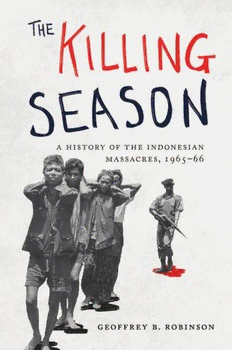
The killing season: a history of the Indonesian massacres, 1965-66 PDF
Preview The killing season: a history of the Indonesian massacres, 1965-66
The Killing SeaSon Human Rights and Crimes against Humanity SerieS editor, eric D. WeiTz A list of titles in this series appears at the back of the book. The Killing Season a hiSTory of The inDoneSian MaSSacreS, 1965– 66 Geoffrey B. Robinson PrinceTon UniverSiTy PreSS PrinceTon & oxforD Copyright © 2018 by Princeton University Press Published by Princeton University Press, 41 William Street, Princeton, New Jersey 08540 In the United Kingdom: Princeton University Press, 6 Oxford Street, Woodstock, Oxfordshire OX20 1TR press.princeton.edu Jacket image: Suspected PKI members detained by army and anti-communist militias near the base of Mount Merapi, Central Java, 1965. Courtesy of the Indonesian National Library (Perpustakaan Nasional Indonesia) All Rights Reserved Library of Congress Cataloging-in-Publication Data Names: Robinson, Geoffrey, 1957– author. Title: The killing season : a history of the Indonesian massacres, 1965–66 / Geoffrey B. Robinson. Description: Princeton : Princeton University Press, 2018. | Includes bibliographical references and index. Identifiers: LCCN 2017039519 | ISBN 9780691161389 (hardcover ; alk. paper) Subjects: LCSH: Political violence—Indonesia. | Political atrocities—Indonesia. | Political prisoners—Indonesia. | Indonesia—History—Coup d’?etat, 1965. | Indonesia—Politics and government—1966–1998. Classification: LCC HN710.Z9 V568 2018 | DDC 303.609598—dc23 LC record available at https://lccn.loc.gov/2017039519 British Library Cataloging- in- Publication Data is available This book has been composed in Miller Printed on acid- free paper. ∞ Printed in the United States of America 10 9 8 7 6 5 4 3 2 1 For Lovisa and Sofia conTenTS Preface · ix Note on Spelling and Translation · xv Abbreviations and Foreign Terms · xvii chaPTer 1 Introduction 3 chaPTer 2 Preconditions 27 chaPTer 3 Pretext 54 chaPTer 4 Cold War 82 chaPTer 5 Mass Killing 118 chaPTer 6 The Army’s Role 148 chaPTer 7 “A Gleam of Light in Asia” 177 chaPTer 8 Mass Incarceration 208 chaPTer 9 Release, Restrict, Discipline, and Punish 237 chaPTer 10 Truth and Justice? 264 chaPTer 11 Violence, Legacies, Silence 292 Notes · 315 Bibliography · 391 Index · 413 [ vii ] Preface The laST TiMe i SaW BUDiarDjo, w e shared a meal at his favorite Chinese restaurant near Piccadilly Circus in London. He told me a little about the evening classes he was taking and his time as a political pris- oner. But mostly we talked about the changes that were then unfolding in Indonesia and his hope that he might finally be able to go home after more than fifteen years. He looked weary, and as always the London cold was getting to him, but otherwise he seemed in good spirits. A few months later, I learned that he had died—t en thousand miles from home, an exile from the country he had served and whose independence he had fought for. Budiardjo’s experience was not unusual. In fact, in many ways, his is the story of millions of Indonesian nationalists and leftists, from all walks of life, who were caught up in the awful juggernaut of arbitrary detention, interrogation, torture, mass killing, and political exile that followed an alleged left- wing coup attempt on the morning of October 1, 1965. Blam- ing the attempt on the Indonesian Communist Party, the army organized a campaign of violence intended to destroy the party and its affiliates and to drive the popular left- nationalist President Sukarno from power. That campaign was aided and abetted by the United States and its allies. By the time the violence ended, an estimated half a million real or alleged Communists had been killed, and another million or so had been arbi- trarily detained. Budiardjo was among them; imprisoned without charge or trial for fourteen years, on his release he fled the country of his birth. If I mention him here, then, it is not because his experience was exceptional but because it was so common, and to make the point that the story I tell in this book is about hundreds of thousands of real people, just like him— husbands and wives, friends and lovers, whose lives were torn apart by the violence and can never again be made whole. When I first learned about these events and the complicity of foreign powers in them, I was sickened and outraged. Today, more than thirty years later, I am still sickened and outraged—a ll the more so because the crimes committed have been all but forgotten and those responsible have not yet been brought to account. Through these years, whatever else I have done, I have never managed to get these feelings to go away. That is prob- ably the single most important reason I have written this book: to share [ ix ]
